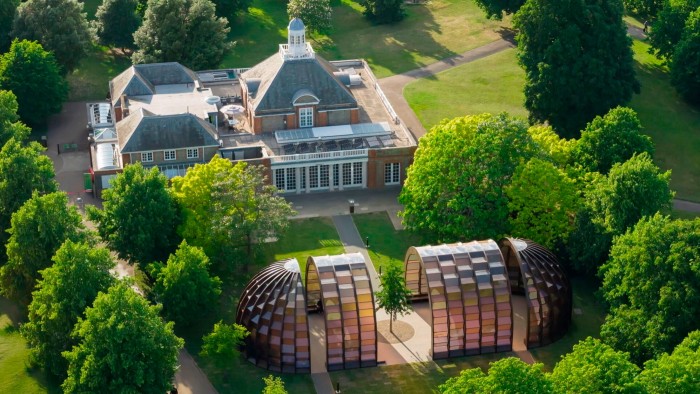Unlock the Editor’s Digest for free
Roula Khalaf, Editor of the FT, selects her favourite stories in this weekly newsletter.
Twenty-five years ago, Zaha Hadid designed a tent outside the Serpentine Gallery in London’s Kensington Gardens. Its white fabric roof was folded into a geometry of irregular triangles, swooping and lifting. It was quite a modest thing, a one-off commission for an acclaimed architect who had at that time, almost unbelievably, never built anything in her adopted home city.
That tent would become the first iteration of an annual programme that has become a highly anticipated summer moment and, looking at this year’s contribution, one which has continued to grow in scale, ambition, expense and expectation. This year’s Serpentine Pavilion comes in the form of a large hangar of a structure designed, in a neat symmetry, by another brilliant woman architect from a Muslim country, Marina Tabassum.
That long run of projects, however, a quarter of a century of commissions, takes a toll in sustaining interest. New themes have emerged over the course of the commissions: climate, sustainability, history, nature and memory (in a very meta move, architects Herzog & de Meuron and artist Ai Weiwei excavated the site to reveal the archaeology of the pavilions themselves). A certain inflation has set in, an increase in impact to maintain visibility. There has been a clear move away from white men (Bjarke Ingels was the last in 2016) but the commission has mostly kept to its core mission of exposing architects who have otherwise not built in the UK before.
Occasionally, the rhetoric clashes with reality. Despite much talk of sustainability, these are solid structures, requiring plenty of concrete and steel, which have to survive the unpredictable English weather through to autumn and accommodate an increasingly demanding schedule of events.
What is a little surprising is that Tabassum, a Bangladeshi architect who is accustomed to working with minimal resources using light-touch materials such as bamboo and woven panels (at least in her work for the poor and marginalised), has employed heavy materials and substantial engineering to create her pavilion this year.
The building is the shape of an extravagant jelly mould, a cylinder with half-domed ends and dark timber arches clad in tinted polycarbonate panels. It is big, and reminded me of those photos of epic, early 20th-century airship hangars. It has also been designed to move, one of its sections sliding to allow different permutations of open and enclosed space, although to me it looked like it might be quite a palaver for not that much effect.

The interior is undeniably impressive, an echo of the vast British greenhouses of the Victorian era. The light is diffused through various shades of brown and the surrounding foliage casts gorgeous, shifting shadows while the open sky remains visible through gaps in the structure. At its centre is a single ginkgo tree, the leaves of which will turn from green to yellow over the course of the pavilion’s existence in the park (for those worried about the harming of trees, it will be replanted in the park after the pavilion is gone). Apparently inspired by the shamiana structures of south Asia, temporary wedding and festival venues that appear overnight saturated with colour and excitement, this capsule is a more refined, more heavyweight version, similarly aimed at creating a sense of occasion and gathering.
Nearby this year is another structure, a “play pavilion” for children which sees the sudden return of white men, this time in the form of 1960s pop radical and Archigram co-founder Peter Cook. His structure, sponsored by Lego (and looking every inch of it), was still under wraps when I visited but there was plenty visible. A garish orange pavilion with layers of Lego applied as decoration in the form of contoured landscapes, it looks a little self-consciously wacky, in the vein of dungareed kids’ show presenters, but also refreshingly unserious. Its folded roof even contains a subtle hint of Hadid’s triangulated structures. Which would be the only subtle thing about it.
Back in the brown, though, it might be that the burden of having to follow so many designs by so many esteemed designers is beginning to result in a certain burden. Lina Ghotmeh’s structure in 2023 similarly struggled to reconcile big social space with the frippery of the temporary. Minsuk Cho attempted to reintroduce a certain playfulness last year, but maybe the pavilions have lost some of the lightness and whimsicality which, you might think, should define a pavilion in a park. Perhaps the world has become a little too dark for pavilions, and architecture has been overburdened with responsibilities.
There is also, counter-intuitively, something a little too finished about this pavilion. It sounds a curious critique but it is very beautifully made, the subtle gradations of tones in brown and beige are super-tasteful and the result is something that looks ostentatiously luxurious, like those exclusive fashion pop-ups in Parisian or Milanese courtyards around catwalk shows.

Yet this remains an astonishing, admirable programme. At the press launch, Serpentine artistic director Hans Ulrich Obrist called it “an architecture without doors — free and open to all”. And absolutely it is. All this costs not a penny of public money (funding comes from Goldman Sachs, among others) and provides an opportunity to experience designs by the world’s most esteemed and intriguing architects first-hand. Its ephemerality is sometimes criticised (including by me), and yet it is also its essence; its impermanence is its urgency. See it while you can.
Opens June 6; ‘Play Pavilion’ by Peter Cook opens June 11; serpentinegalleries.org
Find out about our latest stories first — follow FT Weekend on Instagram, Bluesky and X, and sign up to receive the FT Weekend newsletter every Saturday morning

Leave a Reply